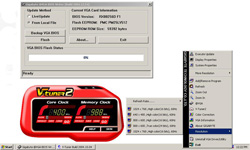Gigabyte's GV-RX80256D X800 Turbo Silent Pipe Video Card
Introduction and Product Specifications
It seems that today's mid and high-end video cards are coming with increasingly more creative cooling solutions. Lately, large, quiet fans are becoming more popular as seen with Abit's OTES, HIS's IceQ II and Sapphire's Lethal Cooling. All of these options aim to keep a video card cool under load while minimizing fan noise, and in some cases, making it virtually non-existent. There are trade offs to these designs, however, such as the occupation of a second slot, but often times the upside is a direct exhausting of warm air out of the case, lowering overall case temperatures. In the end, the benefits outweigh the drawbacks and the end result can be both cool and quiet, which can be a tough combination to find in a performance PC.
While these oversized fan assemblies are growing in popularity, they are not the only silent solutions available. The next most common option is a fan-less heat-pipe outfit that allows for ample cooling of a video card without the need of an on-board fan. The concept of a heat-pipe is nothing new, and can often be found in mini-PC applications. When implemented correctly, the heat-pipe can be an effective cooling solution with the end result being low temperatures and noise.
Today, we're going to review Gigabyte's GV-RX80256D X800 Turbo Silent Pipe Video Card. This model is a fanless design that boasts an oversized heat pipe assembly that straddles the card, aiming to deliver adequate cooling with no added noise. This type of card does require a little more preparation in regards to case cooling, but with proper planning you can end up with a silent card that doesn't require the occupation of a second PCI slot. Let's take a look and see what Gigabyte brings to the fray this time around.
|
For such a large package, the retail bundle of the GV-RX80256D X800 seemed a bit lite. In fact, most of the packing in the box was empty space, designed more to protect the card than to hold a host of extras, as its size might imply. When looking at the bundle, the unit came with the obligatory DVI-to-VGA adapter and an S-Video to HDTV block to help connect to an HDTV ready television. What was missing was the additional cabling needed to connect the block to an actual TV, a component that is becoming more commonplace in even lesser models of late.
The package did include a clear and concise User's Manual that did a good job of covering all aspects of the GV-RX80256D X800's installation. Along with step-by-step images showing how a typical installation goes, GigaByte also goes in-depth on their software complement as well, breaking down the drivers, Gigabyte Utility and V-Tuner2. Completing the package, Gigabyte included two full retail games; Thief – Deadly Shadows and Joint Operations – Typhoon Rising. Lastly, a full-version of CyberLink's Power DVD 5.0 was included to handle your DVD playback needs.
Gigabyte's Utility and V-Tuner2 software was a good addition to the overall product. The Utility sits in the system tray, using minimal resources, yet providing quick access to a host of settings. Along with changing resolutions on the fly, we had quick access to system settings as well as GigaByte's BIOS update utility.
The V-Tuner2 is a straight forward overclocking tool that worked quite well. We were able to adjust the Core and Memory speeds with their respective sliders and then test our settings by hitting Go. If we were satisfied with our speeds, we could save the settings and we were ready to go. The overall interface was very intuitive and even came with the option to skin it for a different look.
Overall, we were impressed with the items Gigabyte chose to include in the package, but felt there was room for some improvement. On the upside, the gaming complement was pretty good and the inclusion of Power DVD and GigaByte's custom software were all an added plus. But Gigabyte should have also included the cables necessary to connect this card to a television.








